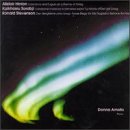| All Artists: Ronald Stevenson, Kaikhosru Sorabji, Alistair Hinton, Donna Amato Title: Donna Amato Plays Alistair Hinton, Kaikhosru Sorabji, Ronald Stevenson Members Wishing: 2 Total Copies: 0 Label: Altarus Release Date: 11/29/1995 Genres: Special Interest, Classical Styles: Historical Periods, Modern, 20th, & 21st Century Number of Discs: 1 SwapaCD Credits: 1 UPC: 076958702129 |
Search - Ronald Stevenson, Kaikhosru Sorabji, Alistair Hinton :: Donna Amato Plays Alistair Hinton, Kaikhosru Sorabji, Ronald Stevenson
 | Ronald Stevenson, Kaikhosru Sorabji, Alistair Hinton Donna Amato Plays Alistair Hinton, Kaikhosru Sorabji, Ronald Stevenson Genres: Special Interest, Classical |
Larger Image |
CD Details |
CD ReviewsThis recording is a hermetic testament to the music of Grieg sbeleu@oltn.odl.state.ok.us | Norman, Oklahoma | 10/21/1998 (5 out of 5 stars) "This recording is a testament to "things of the North" in general, and the music of Edvard Grieg in particular. It begins with Ronald Stevenson's transcription of a Grieg song "Den Bergtekne," which functions as a prelude to the entire recording. The next two pieces are both by Stevenson. "Norse Elegy for Ella Nygaard" uses a theme at its climaxes that, although not a quotation from Grieg, is a Grieg-like theme that the composer associates with him. It is followed by "Beltane Bonfire," which has no direct connection with Grieg, but as a testament to nature as invoked by the musical representation of an ancient Celtic folk ritual, coming after the sorrow expressed in the elegy, functions as music of consolation. The bonfire it invokes was lit to drive away the winter's darkness, an apt metaphor for the music of solace. The following two selections also function as a unit. Sorabji's "Variazione maliziosa..." is a miniature variation of a theme from Grieg's "The Death of Ase." The literary equivalent of an aphorism, it is a radical variation on the Grieg theme. It functions as a prelude to the masterpiece of the recording, Alistair Hinton's "Variations and Fugue on a Theme of Grieg." This is a set of extended variations that are as long and diverse as the Sorabji variation is brief and concentrated. Also based primarily on the "Ase" theme, it also contains allusions to other themes from Grieg, and themes from Paganini, Mahler, Reger, Busoni, and jazz pianist Art Tatum. It runs the procedural gamut from simple to complex variations. If Sorabji's piece is like an aphorism, Hinton's is like an epic.Donna Amato's playing reveals that she is a true disciple of the spirit of Feruccio Busoni."
|
